ADATA XPG SX900 (128GB) Review: Maximizing SandForce Capacity
by Kristian Vättö on June 8, 2012 1:25 AM ESTIntroduction
SandForce sets aside more NAND capacity than most controllers for spare area. While Intel, Marvell, Samsung and others default to ~7% of total NAND capacity for spare area, SandForce is almost double that. The difference boils down to RAISE, SandForce's NAND redundancy algorithm that requires the consumption of a full NAND die. The original idea was that RAISE and SandForce's DuraWrite technology could allow SSD vendors to use cheaper, less reliable NAND without any impact to the end user. It seems as though no one was willing to risk using anything but the best NAND, so we never really saw this feature exploited. A bit over a month ago, ADATA released their XPG SX900 series. It utilizes the oh-so-common SF-2281 controller but unlike other SandForce SSDs, RAISE is disabled - giving the end user more usable space.
Maximizing SandForce Capacity - How it's done
When an SSD is marketed as for example 120GB, it must have 120GB of usable space (before formatting, of course). However, the advertised capacity does not always reflect the raw NAND capacity. Both 120GB and 128GB SSDs actually have 128GiB of NAND onboard. Notice that GB and GiB are not the same. As these two are easily confused with one and another, let's revisit the topic quickly.
Giga is a prefix for billion or 10^9. That means one Gigabyte is 1,000,000,000 bytes. Gibi, on the other hand, is a prefix for 1024^3, or 2^30. Do the math and one Gibibyte works out to be 1,073,741,824 bytes. The confusing part here is that Windows uses Gibibytes for capacities but with the GB abbreviation. (As an aside, Microsoft and others have used "GB" for 2^30 some time, and "Gibibytes" and the other binary SI prefixes only came into being in 1998.) That's why we often say Gigabytes although we really mean Gibibytes. Under Windows, a 128GB SSD is actually shown as a 119GB drive, although in reality it's 119GiB.
As SSDs capacities are advertised in Gigabytes, there is always some "hidden" space thanks to Gigabyte to Gibibyte translation. A 120GB SandForce SSD has ~17.4GB or 12.7% of space that is inaccessible by the end-user. What is that space used for then? Two words: RAISE and over-provisioning.
RAISE (Redundant Array of Independent Silicon Elements) uses the capacity of one NAND die (8GiB for 2x-nm NAND) for parity data. Hence you can lose up to a full NAND package worth of data without losing anything from the user's standpoint. While RAISE is optional, all SandForce SSD manufacturers have enabled it on +120GB drives thus far. 60GB SSDs have RAISE disabled because the user accessible space would be only ~56GB with 8GiB for RAISE and ~7% for over-provisioning.
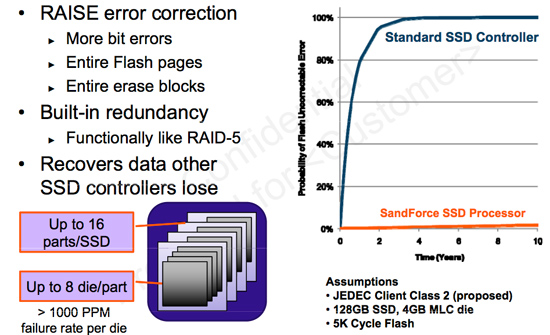
Let's illustrate this situation by looking at how the space in a 120GB SSD is used. RAISE needs a full NAND die so that's 8GiB which needs to be substracted from the raw 128GiB. We are at 120GiB now. As 120GB is user accessible space, that needs to be substracted as well, which means the space left for over-provisioning is ~8.8GB or 6.9%.
So, now we know how the space in a typical SandForce SSD is allocated, but what exactly has ADATA disabled or decreased to achieve a higher capacity? An SSD cannot work without over-provisioning because it would have no space to do garbage collection, wear leveling, and bad block replacement. 0% OP is impossible as the drive could not function if it was filled. That leaves us with RAISE. ADATA has simply disabled RAISE to gain the extra 8GiB and make 8GB of it user accessible (the remaining ~0.6GB is used for OP to keep the OP percentage the same).
And that's it. There are no extra tricks, no extra NAND onboard, and no special controller or other magic. All SF-2200 series controllers support a RAISE-disabled mode, and ADATA is simply the first one to employ it on a drive larger than 64GB. This actually brings us to the next question: What has ADATA done with the 64GB drive?
60GB SandFroce drives already have RAISE disabled because with 8GiB for RAISE and 7% for OP, the usable capacity and hence advertised size would only be 56GB. When RAISE is disabled, there is actually 12.7% left for OP on a 60GB SF drive. ADATA has simply decreased the amount of space dedicated to OP to 7%, which yields a usable capacity of 64GB (or 63.9GB to be exact).
According to SandForce, RAISE is not even necessary for consumer workloads and the built-in 55-bit BCH ECC engine should be effective enough for error correcting. Personally, I would rather lose a small proportion of capacity to prevent potential data loss, but everyone's point of view is different. In my opinion, if you need the extra capacity that one NAND package provides, then your SSD is too small to begin with. It's always a pain in the neck to deal with a drive that's nearly full, especially if it's your boot drive.
The ADATA XPG SX900
ADATA sent us a 128GB review sample. Below is the specification table for the XPG SX900 family:
| ADATA XPG SX900 Specifications | ||||
| Model | 64GB | 128GB | 256GB | 512GB |
| Raw NAND Capacity | 64GiB | 128GiB | 256GiB | 512GiB |
| User Capacity | 59.6GiB | 119.2GiB | 238.4GiB | 476.8GiB |
| Number of NAND Packages | 8 | 16 | 16 | 16 |
| Number of Die per Package | 1 | 1 | 2 | 4 |
| Sequential Read | 550MB/s | 550MB/s | 550MB/s | 540MB/s |
| Sequential Write | 510MB/s | 520MB/s | 530MB/s | 465MB/s |
| 4K Random Read | 15K IOPS | 20K IOPS | 39K IOPS | 55K IOPS |
| 4K Random Write | 87K IOPS | 88K IOPS | 90K IOPS | 47K IOPS |
| Price | $110 | $170 | $330 | $670 |
Performance is exactly what you would expect from a SF-2281 drive. RAISE does not impact performance so this is not surprising.
| Best Online Price Comparison (5/22/2012) | ||||
| 60/64GB | 120/128GB | 240/256GB | 480/512GB | |
| ADATA XPG SX900 | $90 | $160 | $300 | $610 |
| Plextor M3 | $119 | $156 | $279 | $650 |
| Crucial m4 | $80 | $129 | $220 | $535 |
| Intel 520 Series | $115 | $169 | $330 | $819 |
| Samsung 830 Series | $85 | $130 | $285 | $659 |
| OCZ Agility 3 | $70 | $120 | $210 | $500 |
| OCZ Vertex 3 | $85 | $130 | $250 | $660 |
| OCZ Vertex 4 | N/A | $140 | $290 | $640 |
| Mushkin Enhanced Chronos | $68 | $103 | $200 | $450 |
Pricing is not bad but could definitely be more competitive. The SX900 is cheaper than the Intel 520 Series while offering more capacity, but the Crucial m4, Samsung 830 Series, and OCZ Vertex 3 still beat it for most capacities. The Crucial m4 and Samsung 830 Series in particular are the two SSDs that you need to beat in order to succeed--they both offer powers-of-two capacities and seem to be very reliable, and the Samsung 830 Series in particular is also one of the fastest SSDs on the market.
I also decided to include Mushkin in the comparison because many of you have been speaking of their drives in the comments. I won't go in-depth about Mushkin right now, but the Chronos series uses a SandForce SF-2281 controller and asynchronous Micron NAND, which is very similar to OCZ's Agility 3.
It's good to keep in mind, however, that SSD prices fluctuate a lot as sales come and go. I started with the table from our Corsair Performance Pro review, but then widened our search criteria to include other online vendors; there have been plenty of changes just in the past week or so. If you are buying a new SSD, my advice would be to follow the prices for at least a few days, as you can easily save $20 or more by doing so.
As we are dealing with slightly different capacities due to the fact that most SandForce SSDs have RAISE enabled, the best way to look at this data is to compare the price per GB:
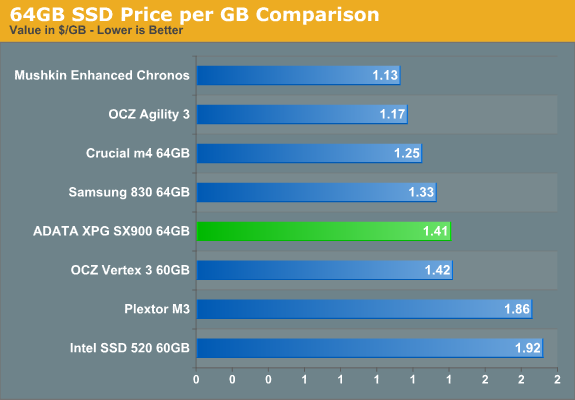
The 64GB model is in the middle of the pack in terms of pricing, basically matching the Vertex 3. The Intel SSD 520 and Plextor M3 are both substantially more expensive per GB, which is not where you want to be for a "value" capacity SSD. Given that factor, the Mushkin is currently the drive to beat for 60/64GB.
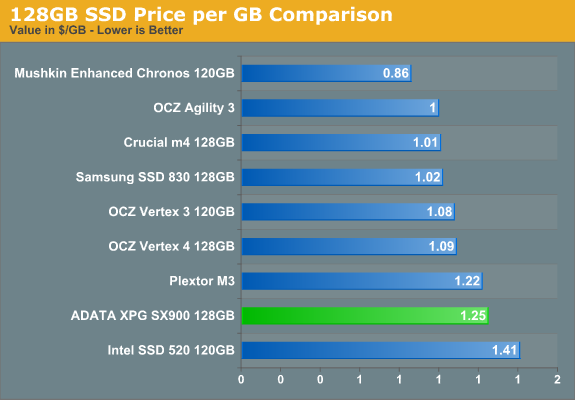
The 128GB SX900 doesn't do very well at 128GB, dropping further down our charts. Price per GB is higher than the other options--again, with the exception of the Intel 520. Even though the SX900 has 8GB more usable space, in terms of value you'd be much better off with something like the Samsung 830, Crucial m4, or the Chronos and Agility 3.
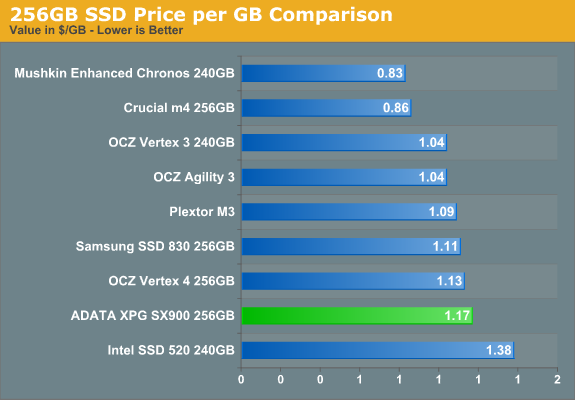
At 256GB, the trend continues with the SX900 again only offering better "value" (not taking into account firmware and reliability factors) than the Intel 520. It's only slightly more than the Vertex 4 and Samsung 830, but again we're looking at the same capacity for those two drives.
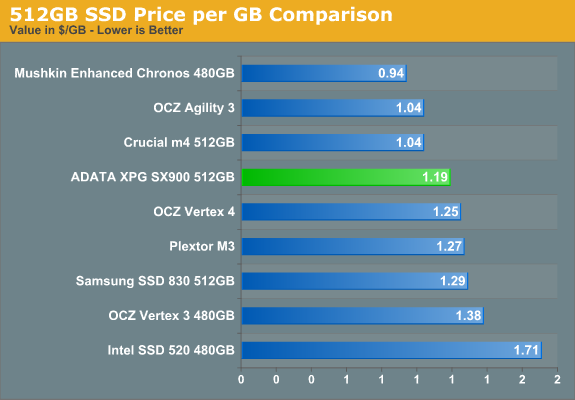
Only at 512GB does ADATA finally manage to place in the top half of our pricing charts. At these capacities, sales volume is much lower due to the overall high pricing, but outside of the Agility 3 and Chronos (which use slightly slower asynchronous NAND), the SX900 is the least expensive SF-2281 based high capacity SSD.
The drive comes with compact packaging. There is a 3.5" desktop bracket included along with mounting screws and a quick installation guide. There is no software CD included but ADATA offers a free Acronis True Image HD download, which is a handy backup/cloning utility. The 3-year warranty that ADATA gives is pretty standard for an SSD, but it could be better as for example Intel and Plextor offer 5-year warranties. The front side of the drive is covered by a big sticker that has ADATA's logo, the model number, and the capacity of the drive.
When we take the drive apart and see what's inside, there's not much out of the ordinary. There are only four screws keeping the whole package in place. It's not unheard of but the typical approach is to screw the PCB on the bottom part of the chassis and then screw the bottom part of the chassis to the top part.
On the actual PCB, there are sixteen 25nm Intel MLC ONFi 2.x (synchronous) NAND devices, eight on each side. Since this is a 128GB drive, it means all NAND devices consist of a single 8GiB die. As expected, the controller is SF-2281.
The Test
| CPU |
Intel Core i5-2500K running at 3.3GHz (Turbo and EIST enabled) |
| Motherboard |
AsRock Z68 Pro3 |
| Chipset |
Intel Z68 |
| Chipset Drivers |
Intel 9.1.1.1015 + Intel RST 10.2 |
| Memory | G.Skill RipjawsX DDR3-1600 2 x 4GB (9-9-9-24) |
| Video Card |
XFX AMD Radeon HD 6850 XXX (800MHz core clock; 4.2GHz GDDR5 effective) |
| Video Drivers | AMD Catalyst 10.1 |
| Desktop Resolution | 1920 x 1080 |
| OS | Windows 7 x64 |


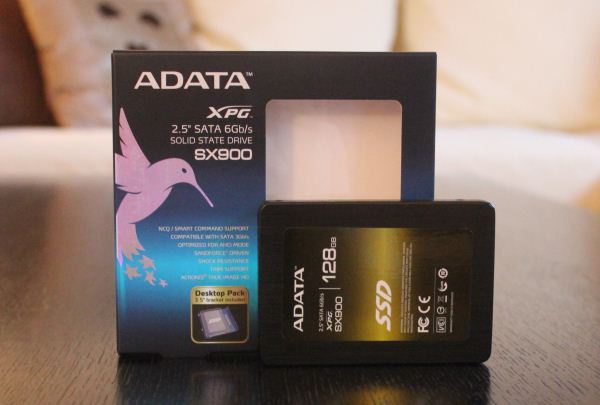
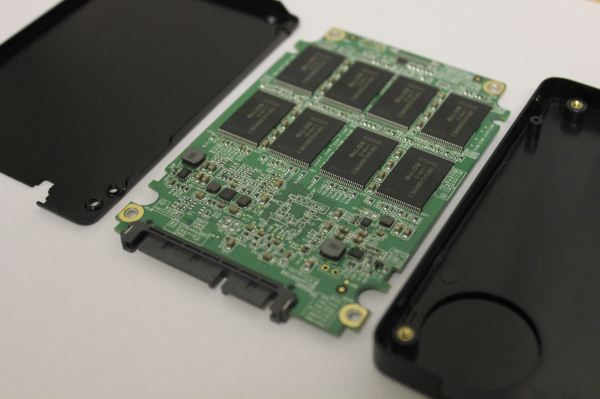
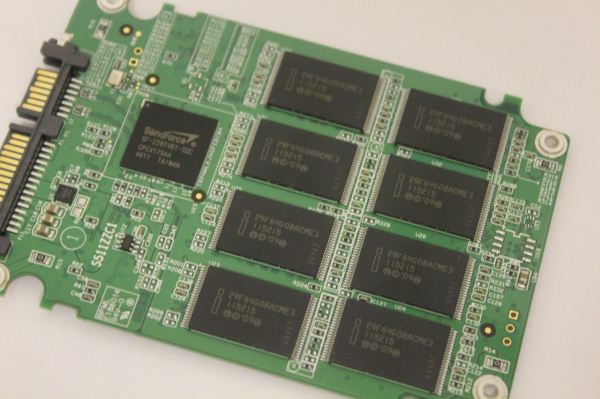








58 Comments
View All Comments
stotticus - Friday, June 8, 2012 - link
I was about to spring for the 256 GB Samsung 830 for my Late 2011 MBP for use as my system drive, based on this site and others' recommendations.On Newegg this drive is cheaper and this review is encouraging. Does anyone have any recommendations for me, as far as this drive being a good choice? My head is spinning trying to wrap around all the tech specs.
iceman98343 - Friday, June 8, 2012 - link
where is your review on new vertex 4 fw?vectorm12 - Friday, June 8, 2012 - link
However I'd really love a comparison between the different SSD controllers concerning write-amplification with uncompressible data.I'm particularly interested in this as I'm constantly evaluating drives for RAIDs aimed at RAIDs. Having a benchmark for write-amplification would really help me estimate lifespan for RAID-volumes based on SSDs.
TheJian - Friday, June 8, 2012 - link
Not sure why you're not using google to get pricing which gives you the best out there. Amazon is selling the 256GB M4 for $205 (shipping included) and the 128GB for $119 (with a good 10 vendors at this price!). That's a pretty awesome price on the 256. These are not the cheapest either (with an ebay guy showing $198 - I'd still buy at amazon though). B&H has the 256 for $205 also. So multiple choices at that price. This engine heads off to newegg where you get screwed (and if you're buying an HD you also get to deal with their wonderful shipping - followed by an RMA because they can't pack a drive to save their life). Amazon and frustration free shipping FTW! :)I'm not going to bother checking the others as I'm only interested in the M4 or Samsung 830. I consider the rest problems (except for Intel, but they are ridiculously priced). Sandforce can go fly a kite with their firmware sucking so bad.
Just an FYI people. GOOGLE your product and hit shopping results on the left side of the screen. Hit compare for the one that shows the most results and then total price (sort). Done.
:)
TheJian - Saturday, June 9, 2012 - link
One more comment I forgot. All your newegg hits serve to set their AUTO PRICING engine off in high gear. Which after so many hits raises the price. It's currently sitting at $144 for the 128GB Samsung 830 which you show $130 for. So all the hits in the last few hours probably drove this up $14.I've watched this happen on a cpu that was rising throughout the day (back when the E8400 came out). I was trying to figure out if I could afford it and just watched it rise. Luckily not many knew it was a xeon 3110 also :) Which I picked up for $20 less and with better thermals :)
Note newegg doesn't work like this for just hits in the list, such as searching for a GTX680 or something and getting a whole list. But an actual viewing of their product page will cause the hit (for any particular product).
Here's hoping you get your SSD for the cheapest possible! As Seagate/WD have been screwing us since the flood. Seagates profits quadrupled (140mil to 563mil) and they shipped 8% fewer drives (overcharging a bit?). How do you QUADRUPLE your profits in a catastrophe? Fabricate the catastrophe, then charge more for everything you ship...LOL. FREAKING QUADRUPLE PROFITS! They did this while shorting your warranty (which will raise the profits even more over the next few years since there will be less they replace with shorter warranty). Seagate shipped 47mil drives (vs. 51 mil previously - not much of a catastrophe). Revenues were 3.2bil (again for 8% fewer drives) vs. 2.8bil before.
Sept 2011 (pre flood) had WD at 239mil income (53.5mil drives shipped). After flood Dec 2011, $145mil (28.5mil shipped drives, with 4Bil in cash, so $199mil for recovery is nothing to them). March 2012, once WD started screwing the customers too they posted 483mil income on 44.2mil drives shipped. So Thailand flooding is a great business for WD. They shipped roughly 10mil less drives in the first 3 months this year compared to sept 2011 pre flood and yet DOUBLED their income from 239mil in that sept PRE FLOOD quarter. So you ship 20% fewer drives (roughly) and double your profits (note that extra 244mil they made this quarter covers ALL flood costs). So this quarter WD will just collect FLOOD PROFITS. Flooding is apparently GOOD for everyone's business. To top that off they are now FULLY recovered and are shipping drives at full capacity now (as of end of May). I wouldn't be surprised to see them top 500mil by cashing in on us. There is NO reason for drives to not be at PRE FLOOD levels for pricing from EITHER company. Sorry about grammar or spelling I've been up all night...LOL
Worse, we now have 1/2 the competition, and idiot reporters are saying pricing won't come down until 2014...UMM...WHY? They're both making money on the flood and eliminated competition. It's been a great year for WD and Seagate...WTF?
The only way to stop them, is to CLOSE YOUR WALLET until pre flood pricing returns! For the love of GOD (or whoever...LOL), quit buying drives! Buy a bluray and a 100 blanks (25TB of storage!) and burn something. Buy an SSD. Just don't buy a stinking hard drive. :)
TheJian - Saturday, June 9, 2012 - link
2.5TB..LOL. No edit...bah.CeriseCogburn - Sunday, June 10, 2012 - link
Thank you for that post TheJianTheJian - Sunday, June 10, 2012 - link
You're very welcome. I hope it either saves you some money or at least closes your wallet to WD and Seagate for a while :)I say that as I have a blu-ray burner (LG WH12LS39-sata burner) and 100 blanks in my cart at amazon... :) The blanks are Optical Quantum (shiny, I hate the white's that bleed paint all over themselves making your drives work harder to read them through the 'fog' so to speak). 100 4x BD-R discs so I can dump a good 2.5TB for $75 ($37x2 50packs), and the drive is $85. Discount shockwave has the drive for $79 but it can take 10 days to get to you and I'm out of space so went for amazon who should have it here in 3 days or so.
Taking my own advice; I hereby close my wallet to seagate until pre-flood (I want that 2TB 2 platter version for $70 like before - they sell a 2 and 3 platter version 4heads vs 6heads until all out of the 3platters I guess). The wallet has been closed to WD for a long while. As a tech in IT I saw too many die (ran hot in dell SFF's which killed them more frequently than seagates/samsung/hitachi) and watched us switch to seagate/hitachi for our stock replacement drives. Of note, WD only had 1% enterprise marketshare until buying Hitachi (not completed yet but will go through no doubt) who has 27% of the enterprise market. Seagate has like 63% of the enterprise share.
http://www.reliant-technology.com/storage_blog/acq...
Jan2012 article. That one shows Hitachi at 24% but they added a few since (can't remember where I got the 27% but it's the latest info - it was a merger article like the one above but an update on proceedings to may or so). We will feel the pain of these two mergers for some time. Of course global HD shares are quite different where WD does very well (equal split with seagate pretty much). Enterprise is getting raped by these guys as they HAVE to replace dead drives. Whereas I can go blu-ray to get buy for a while :) I'm saying a prayer that ALL of you on this board seeking drives go blu-ray (with 50-100blanks) or SSD to get you all by :) And it's been a while since I prayed...LOL.
***promptly gets down on knees and prays, nay, begs, pleads and just plain kisses GOD's ARSE to get people to stop buying Seagate/WD for a while***
CeriseCogburn - Monday, June 11, 2012 - link
Thank you again TheJian, for the further information.A good friend of mine determined the price scalping by general human experience, and it was great to see this, check it out and show him.
I've avoided the spindle drive hike completely and I've been buying SSD's like mad since the spring price drop, so in a sense I've been doing my part to stick it right back to them. :-)
TheJian - Monday, June 11, 2012 - link
You're welcome :)I still can't believe the profits, but it's easy to verify on any stock site. For anyone wanting verification just google stock:stx and hit enter, or stock:wdc and look at their quarterly reports which you can usually view the last 3-4 quarters side by side, check net profits. The top result with show 6-7 news outlets anyone can look at (google finance, yahoo, cnbc, etc).
CeriseCogburn - Thanks for doing your part! :)
That was a bit of typing before, though I had most of the info at the ready. I follow a more than a few tech's, pile up on NVDA and by xmas you'll get some drives for free on them :) - 2/3rd's of their stock price is in cash now...LOL. Easy money by Q1 with Kepler and Tegra3 just taking off (love or hate NV, money is MONEY! I own a radeon 8850 btw...LOL). Unfortunately only a few people will probably see these posts and the raping will continue :(
Kristian?...Could we get an small article on WD and Seagate's profits, and the mass spanking these two are giving us on their drives? I'm guessing if a big site like anandtech did a little diddy on these bozos perhaps these "research" outfits would quit saying they expect no recovery until 2014! That's complete BS as WD has already said they're back to full production (seagate already was, only 8% drop anyway - hardly a catastrophe on their end, hence the quad profits from nowhere). Anandtech could take the bull by the horns and affect world wide pricing. If the ripoff article hit mainstream news media (TV, cnbc?...etc), I'm guessing they'd have to explain something or drop prices. Is this collusion? Price fixing? Even the IHS guy says they won't start a price war and will keep it this way as long as possible with 2 fewer competitors. Collusion?
Most people just don't follow the stocks or realize this is happening. Until you look at profits, you may actually believe they're hurting (especially if you listen to them or their IHS SUPPLY SHILLS - he SHOULD have said drives should drop): This quarter they'll ship more drives than pre-flood. So what if Dell/HP etc signed long term contracts above flood levels. What does that have to do with MY price in the store? Why are all externals still cheap? Why didn't they go up? Surely an anti-hard drive raping article would be quite popular in this crap economy. Artificially keeping pricing high in a down economy should have consequences (at least a bit of bad publicity??).
Anyway, thanks for doing SSD articles Kristian (and Anandtech in general). At least I'm fairly educated on my next pc part purchase (xmas SSD FTW!). Blu-ray and blanks until then...ROFL. AMEN!